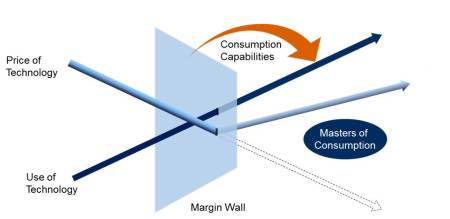First entry of the New Year. Typically, these things are bouncy and optimistic. This time of year, everyone has that “clean desk” mentality. Anything is possible. Unfortunately, I am just not feeling it as the technology sector enters into 2012 In fact, I have a foreboding feeling inside.
The Potential of 2011
Way back in 2009 and 2010, when many sectors were reeling from the global downturn, the tech industry was navigating the stormy seas rather well. Yes, product revenues were down. But service revenues were holding and profits were actually increasing. By the beginning of 2011, product revenues were once again growing and it appeared the tech industry was poised for a wonderful year. But it never came to be.
he Realities of 2011
By the time we took the Q3 2011 snapshot of the TSIA Service 50, it was clear the tech industry was not enjoying the best of years. Every quarter, we compare service margins, product margins, and operating incomes from the same quarter the previous year. The graph below from the Q3 snapshot documents a very humdrum 2011 for the tech companies in the index.
 More specifically, some of the market leaders demonstrated chinks in their financial armor:
More specifically, some of the market leaders demonstrated chinks in their financial armor:
Cisco
Cisco limped through 2011. Their own analysis in their most recent 10-Q is not very encouraging:
Gross Margin
In the first quarter of fiscal 2012, our gross margin percentage decreased by approximately 1.6 percentage points, as compared with the first quarter of fiscal 2011. Within this total gross margin change, product gross margin declined by 2.5 percentage points, while service gross margin increased by 1.5 percentage points. The decrease in our product gross margin percentage was a result of higher sales discounts and unfavorable product pricing, and product mix shifts. Partially offsetting these decreases in product gross margin were lower overall manufacturing costs, higher shipment volume, and lower amortization expense from purchased intangible assets. The increase in our service gross margin was due to increased volume, partially offset primarily by increased costs and to a lesser degree, unfavorable mix impacts.
In other words, Cisco is confirming a very troubling trend:
Product shipments are trending higher, manufacturing costs are trending lower, BUT product margins are trending lower due to increased discounting.
Oracle
Oracle ended 2011 with a financial groan, as documented in this Wall Street Journal article:
Piper Jaffray wrote that Oracle’s Q2 results illustrate a “clearly more sluggish spending environment.” They predicted “continued unexciting growth” over the next two quarters.
The Realities of 2012
The above data is all old news. Right? It’s the New Year! Yes, it is a new year, but I do not see tech shaking this funk anytime soon. In fact, I feel it will get tougher in 2012 for the legacy providers. Even if the global economy does not falter, the financial models for tech companies will struggle in 2012. Why? Because the three most important plays in the tech company playbook don’t score easy points anymore.
Old Play #1: Next Generation Product Release
When margins start to lag, tech companies look for that next hot product release that will reinvigorate pricing points and margins. The margins on new tech products are commoditizing at alarming speeds. Look at everything from the price of an Ethernet port to the price of a tablet computer for validation of this reality.
Old Play #2: Acquire Revenue and Margin
Legacy tech companies with lots of cash on hand love to run this play. Oracle, obviously, has been very proficient at this play as pointed out in the Wall Street article:
But Piper Jaffray saw a silver lining in Oracle’s ability to “acquire companies with 10%-20% operating margins, strip out costs, and rapidly realize 40% operating margins for the acquisition targets”
On Oct. 24 Oracle said it would purchase cloud customer service company RightNow Technologies for $1.5 billion.
“As such, we remain optimistic about Oracle’s aggressive acquisition strategy, which we describe as an ‘earnings arbitrage’.”
Here is the rub: the up and coming stars in tech are not printing cash. Let’s say SAP decided to purchase Taleo to counter the Oracle purchase of Right Now. In their most recent 10-Q, Taleo posted a loss. What if Oracle decided to gobble up salesforce.com? Salesforce, which has been around for over decade, continues to lose money. I am not convinced that Oracle could purchase salesforce, strip out costs, and have a new 40% margin engine. The SaaS model is simply not yet performing at that financial level.
Old Play #3: Cut Costs
Tech companies learned from the largess of the dot com era. Over the past decade, they have become masters of cost control. Which is why there is very little upside left in this play. Unless, of course, tech companies start requiring their employees to travel “cargo class” on business trips.
Adversity Creates Opportunity
Now that I have thoroughly depressed all of my tech industry peeps, let me offer a word of encouragement. Even though I believe 2012 will be a tough year for many tech companies, I also believe 2012 will be a year of business model innovations. I promise to carry this optimism forward in my next post by commenting on some of the wonderful bright spots I see in the industry.




